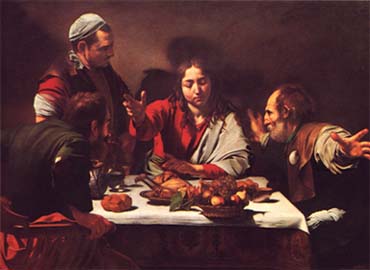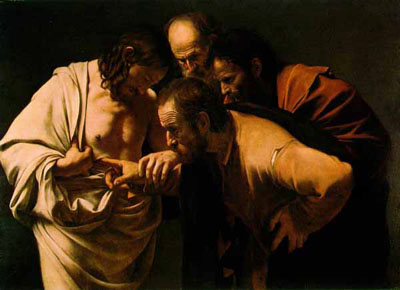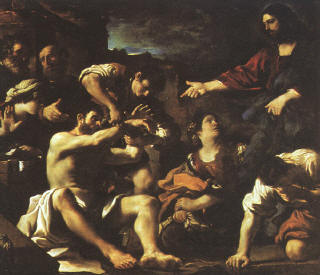He Is Risen! the apostles’
fear and skepticism gave way to faith and joy
by Carlos Mantica Christ triumphed over death
What was it like for Christ to return from the tomb? And how did his disciples react when they saw him again? Did he look the same as before, like someone who goes away on a journey, and then returns? Christ did not just come back in that sense. He went through death for our sake. And he returned not just as he was before, but now as the risen Lord who triumphed over death. That is why Christ’s resurrection is the greatest news that has ever been announced to mankind. The significance of Easter is more than the celebration of Christ rising from the tomb. If the only thing that Christ did was simply return from the dead, then what is so remarkable about that? Other people have risen from the dead as well. We know from the Gospel of John, in chapter 11, that Lazarus rose from the dead, and the lifeless son of the widow of Nain was raised by Jesus as well (Luke 7:11-17). Peter also raised up Tabitha (Acts 9:36). Paul raised up a young boy in Troas named Eutychus, who fell asleep while stting in an open window because Paul’s preaching was so long, and then fell some three stories to the ground (Acts 20:7-12). And even before all these happened, we know of two ealier resurrection stories in the Old Testament—the son of the woman at Shunem was restored to life by the prophet Elisha (2 Kings 4:8-37). And the widow of Zarephath was raised by the prophet Elijah (1 Kings 17:17-24)). In 1975 I personally heard the testimony of a Mexican Indian girl in Texas whom the Lord raised up from the dead, and the testimony of the physicians and nurses who had cared for her. All of these people who were raised ended up dying again. And after a while, no one remembers them or celebrates their “resurrection”. But in Christ’s resurrection something far greater and more significant has taken place. The apostles had witnessed the resurrection of Lazarus, and they saw the lifeless son of the widow of Nain walking once again. But when they announced the resurrection of Christ, they spoke about something unusual, something that had never happened before, something not even conceived in a dream. When the apostles first heard the story told by the women who saw Jesus on Easter Sunday morning, they could not believe it was possible. Like most Jews, except for the Saducees who did not believe that the dead would rise again, the apostles did believe in the immortality of the soul. But the women’s story of seeing Jesus seemed more believable as the appearance of a ghost. Earlier, when Jesus had walked on the water and reached the apostles’ boat in the middle of the night, their first reaction was, “It’s a ghost!” (Matthew 14:26) Put your hands in my wounds!
That Christ could be a ghost was easy for them to believe, and they did believe it. What they could not believe was what they were actually seeing. Ghosts and apparitions do not eat roasted fish for breakfast on the beach, as Christ does by the Lake of Galilee after his resurrection (John 21). Nor do ghosts go about saying the kinds of things that the Lord Jesus said, such as: Receive the Holy Spirit. If you forgive the sins of any, they are forgiven; if you retain the sins of any, they are retained (John 20:22-23).  Supper at Emmaus, by Caravaggio, 1610 The Lord of Life and Death
Christ is the same, and yet he is different. If he were not the same but someone else, then he would not be Christ and we would be referring to a different person. But if he were just the same as before, we would be talking about Jesus of Nazareth but not about the Lord of Life and Death, whom God glorified and to whom he gave a name above every name, the Lord of everything and everone that exists, and before whom every knee bows down in heaven and on earth and below the earth (Philippians 2:9-11). It is the Lord!
He is the same, and yet he is also different. He can enter a room while the doors are closed, and he can appear and disappear at any place or time. He can take different appearances, so sometimes he looks like a gardener, sometimes a traveler going to Emmaus, or a young man strolling on the lake shore, but at the same time you can touch him and put your fingers in his wounds, and he can eat and drink with his friends. He appears as someone who has gone through time and space. He knows all about the past and the future. We will be glorified too!
The resurrection of Lazarus was a simple return to this life, which therefore left him subject to death. Jesus did not return from death, did not evade it, but instead triumphed over it, and his new life was found on the other side of death. And now he cannot die again. Christ inaugurates this new life and this nature. He is the first-born of the risen ones. He is the one who opened the way for all of us who also will live forever, with a body like his. Neither Christ, nor we after being raised by him, will ever die again, but will live forever. Paul explains that all will rise again with the body they now have, in the same way Christ did, but that this body will have been transformed into a glorious body. But our commonwealth is in heaven, and from it we await a Savior, the Lord Jesus Christ, who will change our lowly body to be like his glorious body, by the power which enables him even to subject all things to himself (Philippians 3:20-21).[Carlos Mantica is a past president of The Sword of the Spirit and the founding leader of La Cuidad de Dios, a member community of The Sword of the Spirit in Managua. He is a national advisor of the Cursillo Movement in Nicaragua. He is a prolific writer and noted author and member of the Nicaraguan Academy of Language. This article is adapted from his book, From Egghood to Birdhood: Hatch or Rot as a Christian, 2001. Used with permission.] |
. | |
|
publishing address: Park Royal Business Centre, 9-17 Park Royal Road, Suite 108, London NW10 7LQ, United Kingdom email: editor@swordofthespirit.net |
. |

